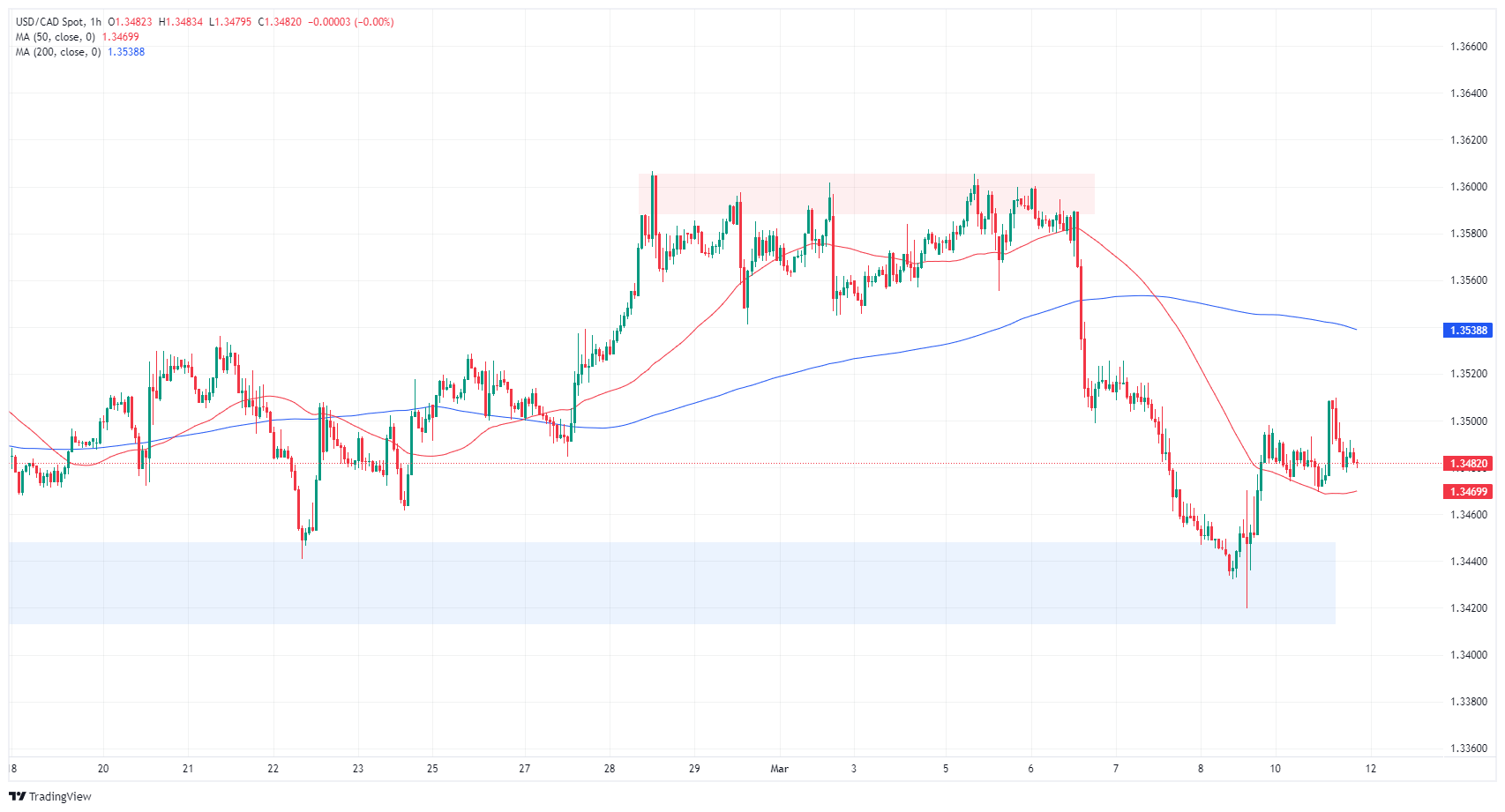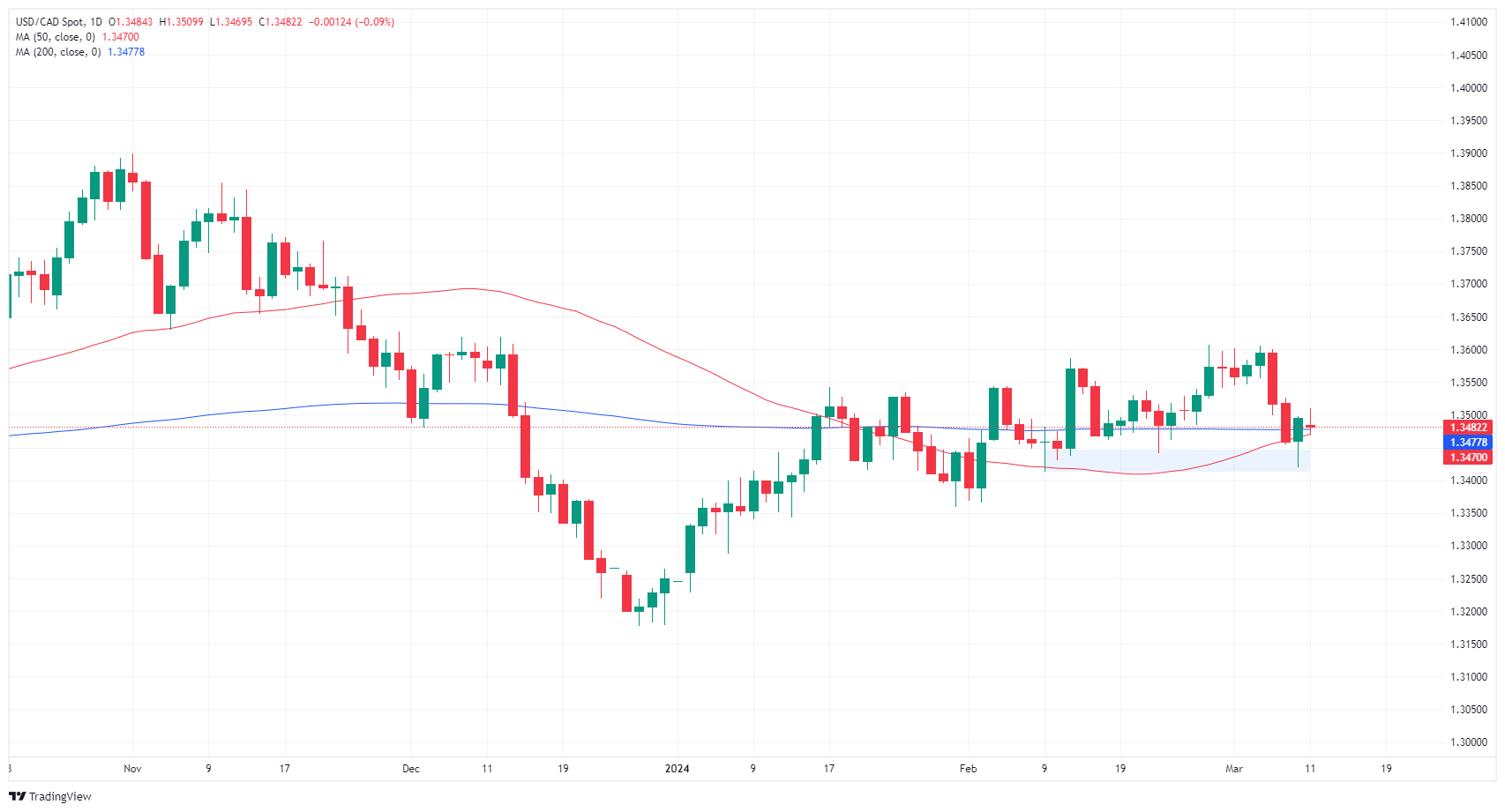- Markets are trading on the thin side as investors await key inflation print.
- Canada has a lean schedule on the economic calendar this week.
- CAD is softly higher across the board on quiet Monday but stuck on USD.
The Canadian Dollar (CAD) had a mild recovery on a quiet Monday, trading into the green against most of its major currency peers as broader markets hunkered down and waited for a push from US Consumer Price Index (CPI) inflation figures slated for Tuesday. Despite moderating into the high side overall, the CAD is stuck close to the day’s opening bids against the US Dollar (USD).
Canada is underrepresented on the economic calendar this week and sees strictly low-tier data releases in the back half of the trading week with Thursday’s January Manufacturing Sales and Friday’s Housing Starts for February. This week’s key data prints will be US CPI inflation for February, which is expected to ease slightly. Thursday will also bring US Retail Sales and a Producer Price Index update.
Daily digest market movers: Markets huddle ahead of another go around the US CPI inflation wheel
- On Monday, the New York Federal Reserve (Fed) noted that US 3-year inflation expectations rose to 2.7% in February, up from the previous 2.4%.
- US 5-year inflation expectations also rose, jumping to 2.9% from 2.5% as consumers turned less optimistic about the future. Near-term inflation expectations held at 3% in the aggregate.
- According to a poll of economists, the Fed is going to be the first of the major central banks to cut rates, with 72 of 108 responding economists saying a first cut will happen in June.
- 52 of 108 economists expect the Fed to cut rates by 75 basis points in 2024, with 26 saying 100 bps.
- Tuesday’s US CPI print is expected to be mixed. The headline MoM CPI is forecast to increase, while Core CPI figures are forecast to decline.
- February’s MoM CPI is expected to print at 0.4% versus the previous 0.3%.
- Core MoM CPI is forecast to tick lower to 0.3% from 0.4%.
- YoY CPI for the year ended February is expected to hold steady at 3.1%.
- MoM Core CPI (headline less volatile food and energy prices) is expected to ease slightly to 0.3% from the previous 0.4%.
- US CPI Preview: Forecasts from 10 major banks, inflation still too high
Canadian Dollar price today
The table below shows the percentage change of Canadian Dollar (CAD) against listed major currencies today. Canadian Dollar was the strongest against the Pound Sterling.
| USD | EUR | GBP | CAD | AUD | JPY | NZD | CHF | |
| USD | 0.13% | 0.35% | -0.03% | 0.19% | 0.05% | 0.15% | 0.07% | |
| EUR | -0.14% | 0.21% | -0.18% | 0.06% | -0.09% | 0.01% | -0.07% | |
| GBP | -0.35% | -0.21% | -0.38% | -0.15% | -0.30% | -0.19% | -0.27% | |
| CAD | 0.02% | 0.14% | 0.36% | 0.20% | 0.04% | 0.13% | 0.08% | |
| AUD | -0.21% | -0.08% | 0.13% | -0.25% | -0.16% | -0.06% | -0.14% | |
| JPY | -0.05% | 0.06% | 0.52% | -0.10% | 0.16% | 0.09% | 0.00% | |
| NZD | -0.12% | 0.00% | 0.21% | -0.17% | 0.06% | -0.09% | -0.07% | |
| CHF | -0.09% | 0.07% | 0.28% | -0.09% | 0.13% | -0.04% | 0.06% |
The heat map shows percentage changes of major currencies against each other. The base currency is picked from the left column, while the quote currency is picked from the top row. For example, if you pick the Euro from the left column and move along the horizontal line to the Japanese Yen, the percentage change displayed in the box will represent EUR (base)/JPY (quote).
Technical analysis: USD/CAD propped up by supply zone, but 1.3500 remains a tricky barrier
The Canadian Dollar (CAD) was broadly higher on Monday, climbing four-tenths of a percent against the Pound Sterling (GBP) and about a third of a percent against the Australian Dollar (AUD). However, the CAD remains close to flat against the USD and the Japanese Yen (JPY).
USD/CAD caught a late bounce last Friday from a familiar supply zone near 1.3440, but 1.3500 remains a tricky handle for the pair, halting a technical recovery into last week’s highs near 1.3600. Despite a steady grind of higher highs, USD/CAD continues to struggle with rough congestion in the midrange as the pair cycles a wide rising range.
Monday’s rise and fall has USD/CAD hung up on the 200-day Simple Moving Average (SMA) at 1.3477. The pair continues to trade into the middle of a rough range since rising into the 1.3500 region in January. A downside break into 1.3400 opens the Loonie to further declines toward late 2023’s lows near 1.3200, while the immediate near-term ceiling sits at the 1.3600 handle.
USD/CAD hourly chart
USD/CAD daily chart
Canadian Dollar FAQs
The key factors driving the Canadian Dollar (CAD) are the level of interest rates set by the Bank of Canada (BoC), the price of Oil, Canada’s largest export, the health of its economy, inflation and the Trade Balance, which is the difference between the value of Canada’s exports versus its imports. Other factors include market sentiment – whether investors are taking on more risky assets (risk-on) or seeking safe-havens (risk-off) – with risk-on being CAD-positive. As its largest trading partner, the health of the US economy is also a key factor influencing the Canadian Dollar.
The Bank of Canada (BoC) has a significant influence on the Canadian Dollar by setting the level of interest rates that banks can lend to one another. This influences the level of interest rates for everyone. The main goal of the BoC is to maintain inflation at 1-3% by adjusting interest rates up or down. Relatively higher interest rates tend to be positive for the CAD. The Bank of Canada can also use quantitative easing and tightening to influence credit conditions, with the former CAD-negative and the latter CAD-positive.
The price of Oil is a key factor impacting the value of the Canadian Dollar. Petroleum is Canada’s biggest export, so Oil price tends to have an immediate impact on the CAD value. Generally, if Oil price rises CAD also goes up, as aggregate demand for the currency increases. The opposite is the case if the price of Oil falls. Higher Oil prices also tend to result in a greater likelihood of a positive Trade Balance, which is also supportive of the CAD.
While inflation had always traditionally been thought of as a negative factor for a currency since it lowers the value of money, the opposite has actually been the case in modern times with the relaxation of cross-border capital controls. Higher inflation tends to lead central banks to put up interest rates which attracts more capital inflows from global investors seeking a lucrative place to keep their money. This increases demand for the local currency, which in Canada’s case is the Canadian Dollar.
Macroeconomic data releases gauge the health of the economy and can have an impact on the Canadian Dollar. Indicators such as GDP, Manufacturing and Services PMIs, employment, and consumer sentiment surveys can all influence the direction of the CAD. A strong economy is good for the Canadian Dollar. Not only does it attract more foreign investment but it may encourage the Bank of Canada to put up interest rates, leading to a stronger currency. If economic data is weak, however, the CAD is likely to fall.
Information on these pages contains forward-looking statements that involve risks and uncertainties. Markets and instruments profiled on this page are for informational purposes only and should not in any way come across as a recommendation to buy or sell in these assets. You should do your own thorough research before making any investment decisions. FXStreet does not in any way guarantee that this information is free from mistakes, errors, or material misstatements. It also does not guarantee that this information is of a timely nature. Investing in Open Markets involves a great deal of risk, including the loss of all or a portion of your investment, as well as emotional distress. All risks, losses and costs associated with investing, including total loss of principal, are your responsibility. The views and opinions expressed in this article are those of the authors and do not necessarily reflect the official policy or position of FXStreet nor its advertisers. The author will not be held responsible for information that is found at the end of links posted on this page.
If not otherwise explicitly mentioned in the body of the article, at the time of writing, the author has no position in any stock mentioned in this article and no business relationship with any company mentioned. The author has not received compensation for writing this article, other than from FXStreet.
FXStreet and the author do not provide personalized recommendations. The author makes no representations as to the accuracy, completeness, or suitability of this information. FXStreet and the author will not be liable for any errors, omissions or any losses, injuries or damages arising from this information and its display or use. Errors and omissions excepted.
The author and FXStreet are not registered investment advisors and nothing in this article is intended to be investment advice.
Recommended content
Editors’ Picks

AUD/USD recovers above 0.6250 amid China's stimulus-led optimism
AUD/USD is recovering ground above 0.6250 early Monday, moving away from multi-month lows of 0.6199 set last week. The pair finds support from renewed optimism linked to reports surrounding more Chinese stimulus even as the US Dollar rebounds at the start of the Christmas week.

USD/JPY: Buyers stay directed toward 157.00
USD/JPY holds firm above mid-156.00s at the start of a new week on Monday. Doubts over when the BoJ could hike rates again and a positive risk tone undermine the safe-haven Japanese Yen while the US Dollar regains its footing after Friday's profit-taking slide.

Gold downside bias remains intact while below $2,645
Gold price is looking to extend its recovery from monthly lows into a third day on Monday as buyers hold their grip above the $2,600 mark. However, the further upside appears elusive amid a broad US Dollar bounce and a pause in the decline of US Treasury bond yields.

The US Dollar ends the year on a strong note
The US Dollar ends the year on a strong note, hitting two-year highs at 108.45. The Fed expects a 50-point rate cut for the full year 2025 versus 4 cuts one quarter earlier, citing higher inflation forecasts and a stubbornly strong labour market.

Bank of England stays on hold, but a dovish front is building
Bank of England rates were maintained at 4.75% today, in line with expectations. However, the 6-3 vote split sent a moderately dovish signal to markets, prompting some dovish repricing and a weaker pound. We remain more dovish than market pricing for 2025.

Best Forex Brokers with Low Spreads
VERIFIED Low spreads are crucial for reducing trading costs. Explore top Forex brokers offering competitive spreads and high leverage. Compare options for EUR/USD, GBP/USD, USD/JPY, and Gold.